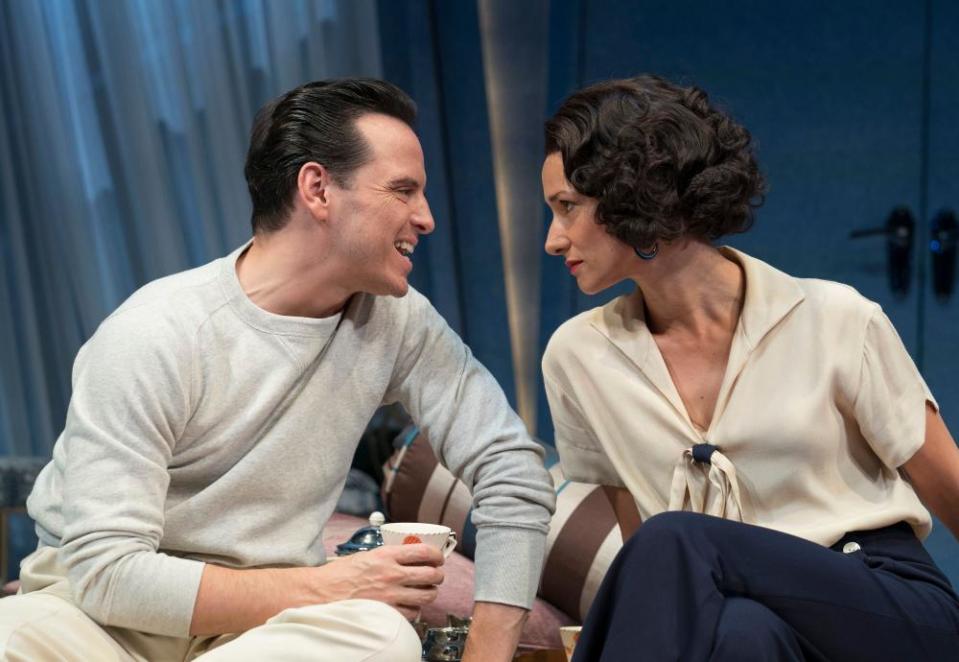Beyond the silk pyjamas: the style of Noël Coward

Noël Coward was the epitome of style. Fittingly that is the subject of a major exhibition opening at London’s Guildhall Art Gallery, containing costumes, set designs, paintings and production photos. Brad Rosenstein, its curator, says Coward is “especially celebrated for his verbal wit” but that the exhibition “will remind us that his original productions were also visual feasts for their audiences”.
That sounds tempting – but it raises several questions. What, actually, do we mean by style? And how has it changed over the years? In Coward’s case, style consisted of the effortless projection of a unique personality. You see that clearly on an album cover of a 1955 LP, Noël Coward at Las Vegas, where he stands in the Nevada desert immaculately clad in dark suit and suede shoes while clutching a cup of tea. I only saw Coward once in the flesh and that was at the first night of a compilation show, Cowardy Custard, at the Mermaid theatre in London in 1972. Although visibly aged, he seemed immensely debonair. But my chief memory is of how John Moffatt dried in the middle of a Coward song. With superb insouciance, Moffatt simply asked the conductor to go back to the beginning of the number. That’s what I call style.
But while some aspects of style are permanent, its visual manifestation alters with time. You can see that by tracking the radical changes that have overtaken one particular play, Present Laughter. First seen in 1943, it is one of the five canonical comedies – the others are Hay Fever, Private Lives, Design for Living and Blithe Spirit – that constitute Coward’s main claim on posterity. Patently autobiographical, it is about a star performer, Garry Essendine, who uses his instinctive charm to protect himself against the clamorous demands of lovers, friends and the world at large.
Coward wrote Garry as “a bravura part” for himself and there’s a photo of a 1947 revival that shows exactly how he must have played it. While being harangued by an angry young playwright from Uckfield (Robert Eddison), Coward – in polka-dotted bow-tie and striped dressing-gown – leans back in his armchair, looking on with amused indifference. That set the pattern for future revivals until Albert Finney played Garry at Manchester’s Royal Exchange in 1977. There’s a wonderful photo of Finney, sporting a tweed suit and brown trilby, confronting the camera with jutting-jawed resolution. Finney banished the idea that Coward must be played with lacquered suavity and gave us a robustly butch Garry who used funny faces and joke voices to ward off ghastly intruders. As Irving Wardle wrote in the Times: “it is as though Lucky Jim had wound up in No 1 dressing-room.”
Sometimes the attempt to escape the Coward imprint can lead to grotesque exaggeration: that was the fault of a Sean Foley Chichester revival in 2018, which I cordially detested. But Andrew Scott in last year’s Old Vic production brilliantly showed that elegance can be combined with innovation. Where Coward’s Garry is first seen in his pyjamas, Scott entered sporting a piratical eyepatch and a brocaded waistcoat as if he had come from JM Barrie’s Neverland. That exactly made the point that Garry, like his author, is a lost boy. As Kenneth Tynan wrote in 1953: “Forty years ago Coward was Slightly in Peter Pan and you might say that he has been wholly in Peter Pan ever since.” But Scott, along with the rest of a talented cast including Indira Varma and Sophie Thompson, proved that style is both innate and a quality that needs to be redefined with each decade.

But what of the idea that Coward’s plays offer a series of visual feasts? It is true but there are far more varied courses to the banquet than custom allows. The stock Coward image is of himself in a dressing-gown and Gertrude Lawrence in a satin Molyneux dress rapturously entwined in Private Lives. But the settings for his work include a railway station buffet (Still Life, which became the movie Brief Encounter), a London pub (Peace in Our Time), an imaginary Pacific island (South Sea Bubble) and aboard a cruise ship (Sail Away). While Gladys Calthrop’s sets gave Coward’s plays an exotic glamour in the 1920s and 30s, today designers feel free to reinterpret them.
The outstanding example is the director-designer Philip Prowse, who has shaken up our visual perception of Coward. At the Glasgow Citizens in 1999 he took Cavalcade, conventionally seen as a patriotic pageant about the first 30 years of the 20th century, and stripped it of false sentiment. One particular scene, in which the recruiting songs of 1914 were accompanied by strange images of death, seemed like a forerunner of Oh! What a Lovely War. And, as Michelle Gomez sang the climactic Twentieth Century Blues with Brechtian ferocity, electronic signs whisked us through the horrors of the years to come. Prowse’s production of Coward’s Semi-Monde, first seen in Glasgow in 1977, also highlighted the decadence of the social butterflies fluttering through the lounge and bar of the Paris Ritz.
Coward was always a mass of contradictions: a proselytiser for bohemianism who worked a 12-hour day, a champion of sexual freedom and a finger-wagging moralist, a cosmopolitan sophisticate who liked to retire to bed early with “something eggy on a tray”. There were many facets to Coward but he indisputably had style; and the art to reviving his work, I’d suggest, lies in finding modern equivalents without simply mimicking the silken elegance of the past.


